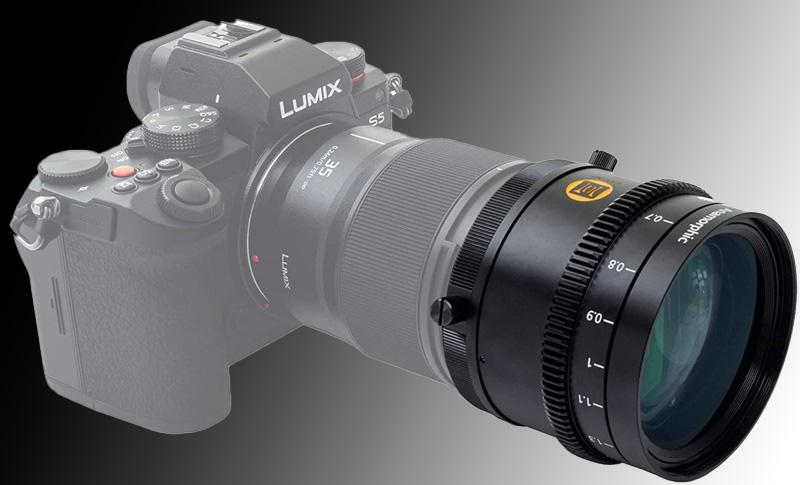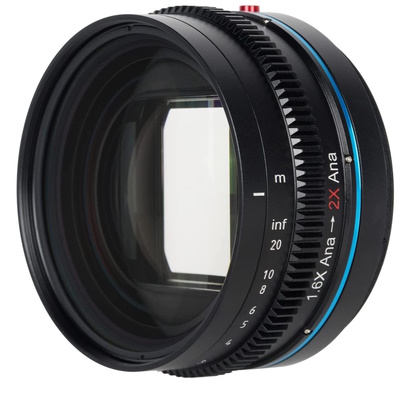Anamorphic adapters are optical accessories that can be attached to a regular camera lens to create an anamorphic effect, which produces a wider aspect ratio than the standard 4:3 or 16:9. As anamorphic lenses are used to create a cinematic look by compressing the image horizontally before it is recorded on the camera’s sensor, and then expanding it back to its original width during post-production.
Why use anamorphic adapters
Anamorphic adapters are commonly used in cinematography to achieve a wider aspect ratio, typically a 2.39:1 aspect ratio, which is wider than the standard 16:9 aspect ratio. This wider aspect ratio provides a more cinematic and immersive look to the footage.
Anamorphic adapters can also provide a unique and aesthetically pleasing look to footage, with distinctive lens flares, oval-shaped bokeh, and a more shallow depth of field.
They can also be used in still photography, particularly in portrait and landscape photography where a wider aspect ratio and unique lens characteristics can enhance the visual impact of the image.

The photo is credited to SLR magic
The pros & cons of using anamorphic adapters
Using an anamorphic adapter has both pros and cons compared to using an actual anamorphic lens. Here are some of the main advantages and disadvantages:
Pros:
- Cost: Anamorphic adapters are generally much less expensive than actual anamorphic lenses, making them a more accessible option for filmmakers on a budget.
- Flexibility: Anamorphic adapters can be attached to a wider variety of lenses than actual anamorphic lenses, allowing filmmakers to achieve an anamorphic look with lenses they already own.
- Portability: Anamorphic adapters are generally smaller and lighter than actual anamorphic lenses, making them a more portable option for run-and-gun shooting.
- Compatibility: Anamorphic adapters can be used with a wider range of cameras and sensors than actual anamorphic lenses, which are often limited to specific mounts and sensor sizes.
Cons:
- Optical Quality: While some anamorphic adapters offer high-quality optics, it can be difficult to achieve the same level of optical performance as an actual anamorphic lens. Adapters may introduce optical artifacts such as distortion, chromatic aberration, and flares.
- Setup Time: Using an anamorphic adapter requires attaching the adapter to a lens and aligning it properly, which can be time-consuming and may require additional gear such as a follow focus and matte box.
- Focus and Iris Control: Depending on the adapter and lens combination, controlling focus and iris can be more difficult than with a dedicated anamorphic lens, as adapters may not transmit lens data to the camera or require separate focus and iris controls.
- Limited Options: While there are many different anamorphic adapters available, the selection is still more limited than that of actual anamorphic lenses. Some anamorphic adapters may only be compatible with certain lenses or cameras, limiting their flexibility.
Ultimately, the decision to use an anamorphic adapter or an actual anamorphic lens will depend on the specific needs and budget of the filmmaker, as well as the desired level of optical performance and ease of use.

Anamorphic adapter types:
Anamorphic adapters are used in cinematography to achieve a wider aspect ratio by horizontally squeezing the image onto the camera’s sensor or film stock, which is then unsqueezed in post-production. There are different types of anamorphic adapters, including:
- Clamp-on anamorphic adapter: These adapters are designed to be clamped onto the front of a prime or zoom lens, allowing you to quickly attach and detach them from your setup.
- Bayonet mount anamorphic adapter: These adapters feature a bayonet mount that allows them to attach directly to the camera body, eliminating the need for an additional lens mount.
- Rear-mounted anamorphic adapter: These adapters are mounted on the rear of a lens, allowing you to use them with a wider variety of lenses.
- Front-mounted anamorphic adapter: These adapters are mounted on the front of a lens, typically with a screw-on or bayonet mount, and are used for achieving a wider field of view.
Common specifications of an anamorphic adapter
Anamorphic adapters can have a variety of specifications that affect their performance and compatibility with different lenses and cameras. Here are some common specifications you might see:
- Squeeze Factor: This refers to the amount of horizontal compression applied by the anamorphic adapter. For example, a 1.33x anamorphic adapter will stretch the image horizontally by a factor of 1.33, resulting in a wider field of view and a distinctive oval-shaped bokeh.
- Front Filter Thread Size: This refers to the size of the front filter thread on the anamorphic adapter. This is important because it determines which filters or step-up rings you can use with the adapter.
- Lens Compatibility: This refers to the types of lenses that the anamorphic adapter is designed to work with. Some adapters may be designed for use with cinema lenses, while others may be compatible with stills lenses or both.
- Minimum Focus Distance: This refers to the closest distance at which the anamorphic adapter can focus. This is important if you plan to shoot close-up or macro footage.
How to choose an anamorphic adapter
When selecting an anamorphic adapter, there are several factors to consider, including:
- Compatibility: Anamorphic adapters may be designed for use with specific lens mounts or sensor sizes, so it’s important to ensure that the adapter you choose is compatible with your camera and lens.
- Squeeze Factor: The squeeze factor determines how much the image is horizontally compressed by the anamorphic adapter. Common squeeze factors include 1.33x, 1.5x, and 2x. A higher squeeze factor will result in a more pronounced anamorphic look, but it may also introduce more distortion and require a wider aspect ratio for playback.
- Image Quality: Anamorphic adapters can introduce some optical artifacts, but a good adapter should minimize these effects and deliver high-quality images. Look for adapters with high-quality optics, anti-reflective coatings, and other features that enhance image quality.
- Build Quality: Anamorphic adapters are precision optical instruments, so it’s important to choose one that is well-built and durable. Look for adapters made from high-quality materials and with robust construction.
- Focal Length: The focal length of your lens can affect the performance of an anamorphic adapter. Longer lenses (50mm or above) tend to work best with anamorphic adapters, as they minimize distortion and produce a more cinematic look. However, adapters may be available for shorter lenses as well.
- Minimum Focus Distance: The minimum focus distance is the closest distance at which the anamorphic adapter can focus. This is important if you plan to shoot close-up or macro footage.
- Price: Anamorphic adapters can range in price from a few hundred dollars to several thousand dollars, so it’s important to consider your budget when selecting an adapter. Keep in mind that a more expensive adapter may offer better image quality and durability, but it may not be necessary for all types of filmmaking.
Finally, by considering these factors and doing research on different anamorphic adapters, you can select the best one for your needs and achieve the unique anamorphic look you desire.
Low-budget anamorphic adapters
There are several anamorphic adapters available in the market that can be attached to a standard camera lens. Generally speaking, their prices increase with the increase of the squeeze factor of the adapter. The following are some good options of low budget anamorphic adapters:
SLR Magic Anamorphot-40 1.33x Anamorphic Adapter
Key Features
- 33x Anamorphic Squeeze Adapter
- For up to 40mm Front Diameter Lenses
- Mounts to Lenses with 52mm Front Thread
- Creates 2.35:1 Images on 16:9 Sensors
- For Full-Frame and APS-C Cameras
- For 40mm or Longer Lenses in Full Frame
- Near/Normal Focus Adjustment
- Compact Design
Compatible with AF and MF Lenses with the SLR Magic Anamorphot-40 1.33x Anamorphic Adapter, you can shoot footage in a 2.35:1 aspect ratio on your camera with a 16:9 sensor. This will result in an image that appears stretched taller and thinner than normal but can be easily corrected in post-production using any modern NLE software, making it suitable for wide-screen viewing.
The Anamorphot-40 1.33x works best with lenses having a front element diameter of up to 40mm, and for full-frame sensors, it is recommended to use a 40mm or longer focal length lens. However, when using S35 and Micro Four Thirds sensors, select wider lenses that are compatible with this adapter.
The Anamorphot-40 adapter comes with an adjustable focus marked as normal and near. The near setting allows you to focus on subjects that are two feet away, while the normal setting allows focusing on subjects from three feet to infinity. This adapter attaches to lenses with a non-rotating front and a 52mm front filter thread, making it compatible with both automatic and manual focus lenses as well as full-frame and APS-C camera sensors.
Examples of compatible Lenses:
Canon EF 40mm f/2.8 STM, Canon EF 50mm f/1.8 STM, and Canon EF 50mm f/1.8 II at f/2.8 or smaller for (full-frame or APS-C sensor)
Sony FE 28mm f/2, and Sony FE 35mm f/2.8 ZA for (APS-C sensor)
SIRUI 1.25x T2.9 Anamorphic Adapter
Key Features
- 25x Anamorphic Squeeze Adapter
- For up to 85mm Front Diameter Lenses
- Mounts on Lenses with 82mm Front Thread
- Creates 16:9 Images on 4:3 Sensors
- 2x Squeeze on 1.6x Anamorphic Lenses
- Creates 20:9 Images with Spherical 16:9
- For Full-Frame, APS-C & MFT Cameras
- Compact, Lightweight Design
The Sirui 1.25x Anamorphic Adapter is a versatile device that can transform a spherical lens into an anamorphic lens or enhance the squeeze ratio of an existing anamorphic lens. Whether you want to produce a 1.25x anamorphic effect with a spherical lens or a super-wide 2x squeeze with a 1.6x anamorphic lens, this lightweight and compact adapter can be easily mounted on lenses via a rear 82mm thread. It also provides a wide compatibility range by enabling the use of separately available 92mm step-up or 67, 72, and 77mm step-down rings.
Moreover, the Sirui 1.25x Anamorphic Adapter is designed to increase anamorphic effects and facilitate reframing. It creates a 16:9 aspect ratio when used with 4:3-sensor cameras and a 20:9 aspect ratio when used with spherical lenses in 16:9. It works equally well with both spherical and anamorphic lenses and can create a 1.25x squeeze on spherical lenses, while 1.6x anamorphic lenses can achieve a super-wide 2x squeeze.
Moment 1.33x Anamorphic Lens Adapter
Main Features:
- 33X Magnification (convert 16:9 to 2.35:1)
- Front focus adjustment via built-in rangefinder lens
- Compatible with many existing modern and vintage prime lenses
- Included adapters fit 67mm, 72mm, 77mm, and 82mm filter threads
- Easily adjustable orientation
- S35+ Format (full-frame on some compact lenses)
- All-metal housing
This anamorphic adapter is affordable, easy to use, and adapts your existing lenses for endless possibilities. The Moment Anamorphic Adapter has a 1.33x squeeze that transforms the 16:9 video into a glorious widescreen 2:35:1 frame.
Anamorphic adapters haven’t always been accessible or easy to use. However, Moment 1.33x Anamorphic Lens Adapter quickly screws on the front of your existing photo, cinema, or vintage lenses, and with the quick press of a button to orient the lens, you’ll be shooting in 30 seconds or less.
Some anamorphic lenses don’t have front threading and require using matte boxes for filters like Variable ND Filters. This adapter has an 82mm filter thread which allows the use of the filter easily and without the need for an additional accessory.
SmallRig 1.55XT Anamorphic Lens for iPhone and Android

Key Features
- Compatible with Select iPhones and iPads
- Compatible with Select Android Devices
- Performs a 1.55x Horizontal Squeeze
- Create Videos with a 2.76:1 Aspect Ratio
- 120° Diagonal Field of View
- 52mm Filter Mount
- Low Dispersion Glass
- Create Lens Flares
- Multi-layered Anti-Reflective Coating
- Aluminium Alloy Frame
The 1.55X Anamorphic Lens from SmallRig is designed to be compatible with most smartphones and tablets, and it offers a significantly wider aspect ratio of 2.76:1, which is much greater than what standard optics can achieve.
By vertically stretching a wider image onto your phone’s sensor, anamorphic lenses are able to increase the lens’s horizontal field of view by 55%, resulting in a unique aspect ratio that is different from the typical spherical ratio of 16:9 (1.78:1).
Additionally, the use of anamorphic lenses in strong light sources can produce interesting lens flares that add to the visual appeal of your video. The lens is also equipped with a multi-layered broadband optical coating that is anti-reflective, and it has a 52mm thread mount that allows for external filters to be attached.
Finally, the aluminum alloy frame provides the lens with durability and sturdiness.
Can’t afford a brand-new lens or adapter?
Sometimes, buying a new Lens can be very expensive for many people. However, Keh is a great option to get a used one at a reasonable price. Read the full review here.
RELATED POSTS
What Is Anamorphic Lens? – Everything You Need To Know
Thanks for reading, I hope you enjoyed the article, in case you have any questions just drop them below & I will be happy to answer you.
If you enjoy the site, don’t forget to subscribe, we will only inform you when a new article is posted.













Thank you Amin, for this excellent overview of anamorphic adapters, what they are used for, how they are setup and employed and for taking the time to give such a common sense description of how they even work in the first place.
I have employed certain filters in my camera work for YouTube and the effects that got describe here sounds an awful lot like a really high tech camera filter. To the point that achieving this affect would seem to require a heart rending amount of setup and maintenance.
You do a tremendous job though showing how simple these adaptors can be. The 1.55X Anamorphic Lens from SmallRig looks ideal for my usage. Can you tell me anything negative about that specific adapter?
Thanks for your comment, there is nothing specific regarding the SmallRig adapter, however, you have to remember that all the anamorphic adapters have some limitations and drawbacks such as:
They can reduce the sharpness of the image, particularly at the edges of the frame. They can also cause vignetting or darkening at the corners of the image. Finally, while they can be used with many lenses, they may not work with all lenses or camera bodies. It’s important to check the compatibility of the adapter with your specific gear before purchasing.
Thanks again for your feedback
Hello Amin,
According to your how to turn any lens into an anamorphic lens, which is a technique that can be of interest to photographers and videographers who want to achieve a specific look in their work. This can be important for providing a unique and creative approach to photography and videography.
Then, it offers practical advice on how to modify a lens to create an anamorphic effect, which can be helpful for readers who may be interested in trying the technique for themselves. It can also be important for establishing the author as an expert in their field.
And then, the author provides visual examples of the anamorphic effect, which can help readers understand how the technique can be used to enhance their work. This type of content can also be engaging and inspiring for readers.
Finally, according to my understanding, your review appears to be informative, practical, and visually appealing, which can be important for building a loyal audience and establishing the blog as a valuable resource for photographers and videographers who are interested in experimenting with new techniques. as well as it provide more opinion to buy the related products.
Thanks for sharing us
SAM
Hi Samantha
Thank you for your comprehensive comment, I really appreciate your feedback.
As a photographer, I always admire pictures when they come out with a cinematic outlook. I have not bought an anamorphic lens because of its high cost. Thank you for helping me see how I can use adapters to reduce this cost and generate a beautiful outlook. I am more excited with the anamorphic adapters’ high and wide range of compatibility
Thanks for your comment, Anamorphic adapters can indeed be a cost-effective solution for achieving a wider aspect ratio and other unique optical characteristics that are typically associated with anamorphic lenses.